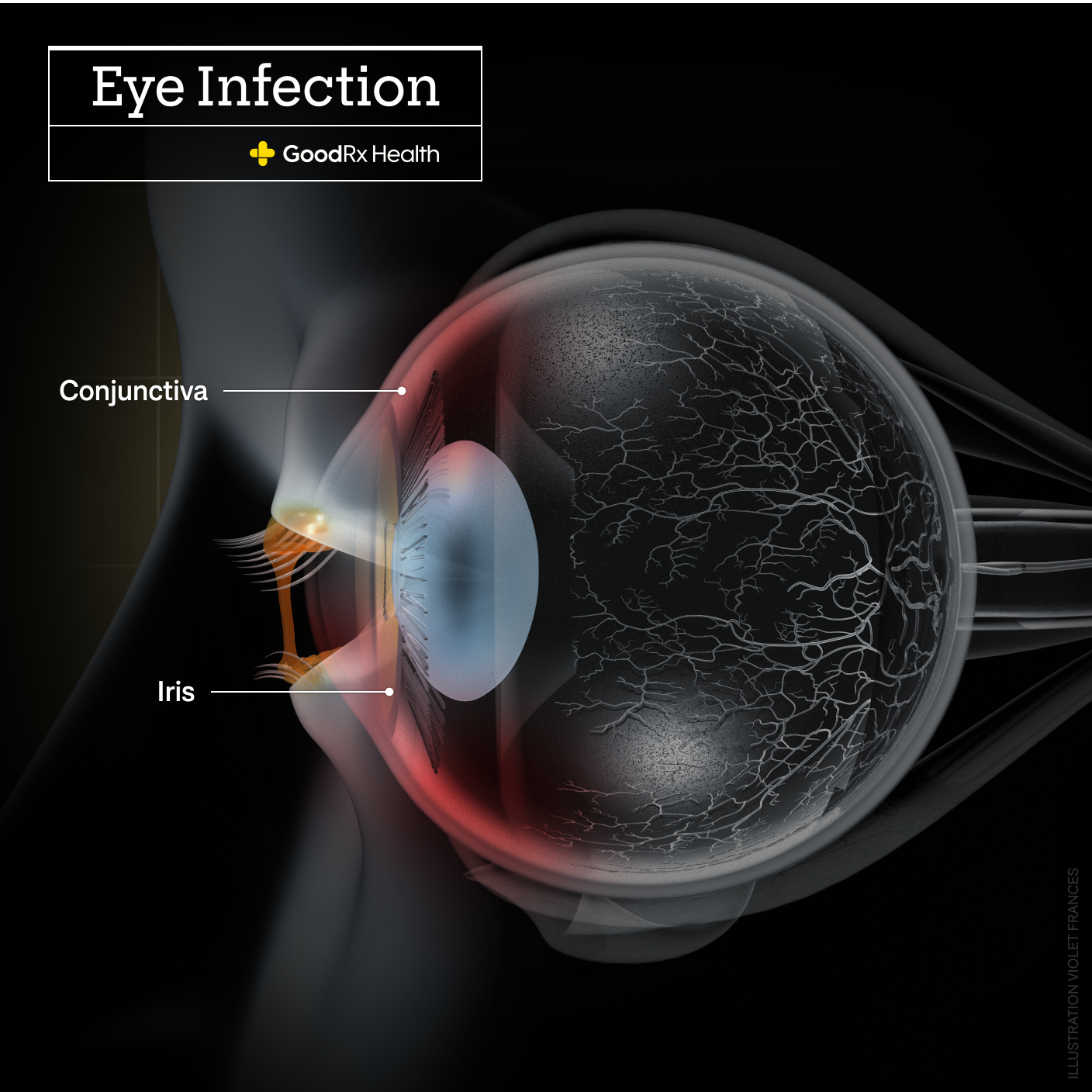Key takeaways:
About 1 in 10 people develop eye symptoms when they have COVID-19.
Conjunctivitis (pink eye) is the most common COVID eye symptom.
COVID can also cause eye pain along with dry eye, redness, and blurred vision.
By now, we all know that COVID-19 affects the lungs and the heart. But did you know that COVID can also affect your eyes and vision? Studies show that COVID can affect all layers of the eye, starting at the cornea and ending at the retina. Here’s what you should know about how COVID can affect your eye health.
What eye symptoms can COVID-19 cause?
People who get sick with COVID can develop many different eye symptoms in one or both eyes. The most commonly reported ones are discussed below.
1. Eye pain
COVID infections can cause eye pain. This can feel like a dull, aching pain. You may also notice light sensitivity. Pain can develop when the virus triggers eye inflammation, dry eye, or infection.
Search and compare options
2. Redness
COVID can also cause eye redness (bloodshot eyes). This can be a sign of inflammation, COVID pink eye, or worsening dry eye.
3. Itching
Eye itching can develop with COVID eye infections, like pink eye. Itching can also be a sign of worsening dry eye. Some people experience itching when they have eye inflammation. COVID illness can trigger new eye inflammation. It can also make existing eye inflammation worse.
4. Eye discharge
Yellow or green eye discharge is a common symptom of COVID-related pink eye. Eye discharge can also be a sign of another type of eye infection. COVID can cause inflammation in the eye. This may increase the risk of developing an infection.
5. Vision changes
COVID can cause vision changes, especially blurry vision. This happens because COVID can worsen underlying conditions like dry eye. COVID can also trigger inflammation in the uvea or retina, which can lead to vision changes.
Can COVID-19 cause pink eye?
Yes, COVID can cause eye infections. Like many other viruses, COVID can cause conjunctivitis, or “pink eye.” This happens when the virus infects the outer layer of the eye, called the conjunctiva.

COVID conjunctivitis is the most common eye problem caused by the COVID virus. Omicron variants are more likely to cause pink eye than older variants.
COVID is one of several causes of red eyes. Our experts review the most common causes of red, bloodshot eyes.
How can you tell if you have pink eye? Our pink eye quiz can help.
Are you still contagious? Here’s how long you’re contagious with COVID and when you can stop isolating.
There’s no medication that can cure COVID conjunctivitis. The infection will go away on its own over time. Antibiotic eye drops can’t cure COVID conjunctivitis.
A healthcare professional might recommend artificial tear drops, which will help relieve some of your COVID eye symptoms like itching and redness. The drops will also keep your eyes moist, which is important for the overall health of your eyes.
What are the most common eye problems linked to COVID-19?
About 1 in 10 people with COVID develop an eye-related symptom, like eye pain or redness. Most often, these symptoms are from COVID conjunctivitis.
Read more like this
Explore these related articles, suggested for readers like you.
But COVID can cause other eye conditions, too, including those mentioned below.
Dry eye
COVID can cause a condition called dry eye. COVID can also make dry eye worse for people who already have the condition. Dry eye can lead to vision changes, eye pain, and redness. Treatment can help ease symptoms and prevent long-term vision damage.
Corneal nerve damage
The COVID virus can injure the nerves that go to the cornea, the clear covering of the eye. This can lead to blurred vision and eye pain. People with corneal nerve damage are also at higher risk for developing eye infections. They can also develop scars on their cornea that can damage vision.
Uveitis
COVID can trigger uveitis. Uveitis is inflammation of the front part of the eye. People with uveitis experience eye redness, sensitivity to light, and eye pain. Uveitis can cause vision loss.
Retina damage
The retina is the back part of the eye that processes images. COVID can cause bleeding and inflammation in the retina. This can permanently damage your vision.
How can you treat COVID-19 eye symptoms?
See your eye doctor as soon as possible if you’re experiencing mild eye symptoms during your COVID illness. They can perform an eye exam to see if you have dry eye or pink eye and offer treatment options to help you recover. There are also home remedies you can try to treat mild COVID eye symptoms.
Cool compress
You can run a washcloth under cool or cold water and then lay it over your closed eyes for 10 to 15 minutes. This can help ease redness and itching. A cool compress can also help get rid of any crusting from eye discharge.
Warm compress
A warm compress can help your eyes’ oil glands open up, which can help lessen dry eye symptoms. You can buy a reusable warm pack that’s made for use over the eyes. Or you can make your own warm pack with a sock and dry white rice.
Artificial tears and saline rinses
Artificial tears and saline eye rinses are available over the counter (OTC). They can help soothe eye itching and redness. Make sure you only use sterile saline to rinse your eyes. Never use tap water, which can lead to eye infections.
Also, not all eye drops are the same. Stick with ones labeled as “artificial tears.” Some eye drops are marketed for eye redness relief, but they may worsen dry eye symptoms.
Eye ointment
If you’re experiencing dry eye or eye itching, use a lubricating eye ointment before going to bed at night. They’re much thicker than artificial tears, so they’ll blur your vision. Because of this, they should only be used at bedtime. Eye ointments are available OTC.
When to see a medical professional
See an eye doctor (ophthalmologist or optometrist) right away if you’re experiencing eye pain or vision changes while sick with COVID. They can make sure you’re not experiencing a vision-threatening condition like uveitis or retinal bleeding.
You should also see an eye doctor if your COVID eye symptoms don’t get better within 2 to 3 days. You may need additional tests or treatments to help your symptoms. If you wear contact lenses, see your eye doctor as soon as you develop symptoms. People who wear contact lenses are at higher risk for developing severe eye infections that pose a risk to vision.
Can you prevent COVID-19 eye problems?
If you’ve recently been diagnosed with COVID, there are several things you can do to protect your eyes:
Avoid touching your eyes, as much as possible.
Wash your hands often with soap and water.
If you wear contact lenses, make sure you’re cleaning and storing your lenses properly.
Don’t share towels or other personal items that go near your face and eyes.
If your eye doctor recommends eye drops or artificial tears, make sure to use them as directed. Eye drops can help keep your eyes healthy and your vision safe. If you notice your symptoms getting worse even with treatment, get in touch with your eye doctor right away.
Frequently asked questions
Yes, you can catch COVID through your eye. Our eyelids are lined with a mucous membrane — the same type of tissue that lines our nose, mouth, and throat. When a person with COVID coughs or sneezes, small droplets containing the virus are released. If these reach the mucous membrane under the eyelid of another person, it can lead to COVID infection.
Most COVID symptoms last for 1 to 14 days. But for some people, COVID symptoms can last significantly longer. Some studies found that COVID eye symptoms could last for months after recovery from COVID.
Yes, you can catch COVID through your eye. Our eyelids are lined with a mucous membrane — the same type of tissue that lines our nose, mouth, and throat. When a person with COVID coughs or sneezes, small droplets containing the virus are released. If these reach the mucous membrane under the eyelid of another person, it can lead to COVID infection.
Most COVID symptoms last for 1 to 14 days. But for some people, COVID symptoms can last significantly longer. Some studies found that COVID eye symptoms could last for months after recovery from COVID.
The bottom line
COVID can affect your eyes. In fact, about 1 in 10 people develop an eye symptom from COVID like redness, itching, or discharge. Conjunctivitis (pink eye) and dry eye are the most common eye problems that develop with COVID infection. If you’ve recently been diagnosed with COVID and you develop any eye symptoms like redness, tearing, wateriness, or blurry vision, make sure to see an eye doctor as soon as possible.

Why trust our experts?



References
Bitirgen, G., et al. (2021). Corneal confocal microscopy identifies corneal nerve fibre loss and increased dendritic cells in patients with long COVID. British Journal of Ophthalmology.
Centers for Disease Control and Prevention. (2024). About COVID-19.
Encyclopedia Britannica (2025). Mucous membrane.
Lagali, N., et al. (2023). Postcovid eye syndrome: Ocular symptoms and anterior segment findings. Investigative Ophthalmology & Visual Science.
Nasiri, N., et al. (2021). Ocular manifestations of COVID-19: A systematic review and meta-analysis. Journal of Ophthalmic & Vision Research.
Ng, H. W., et al. (2024). Ocular manifestations of COVID-19. Progress in Retinal and Eye Research.
Saban, O., et al. (2025). COVID-19: ocular manifestations and associations with corneal transplant rejection and uveitis reactivation. Current Opinion in Ophthalmology.
Sen, M., et al. (2021). COVID-19 and eye: A review of ophthalmic manifestations of COVID-19. Indian Journal of Ophthalmology.
Sohn, E. (2023). What is causing so much pink eye? Scientific American.
Stawowski, A. R., et al. (2024). The review of ophthalmic symptoms in COVID-19. Clinical Ophthalmology.
World Health Organization. (2023). Coronavirus disease (COVID-19).















